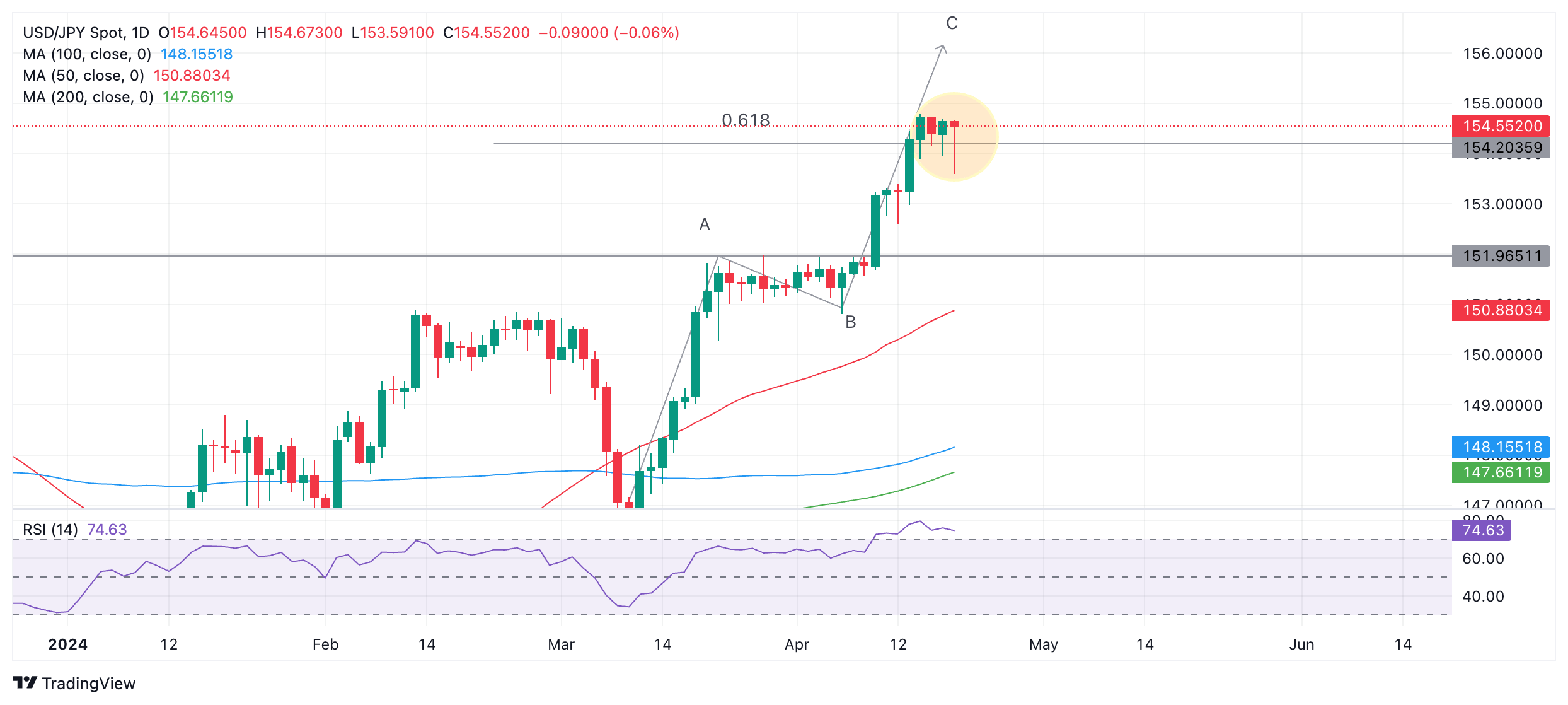- The USD/JPY rises and falls due to the alternation of risk appetite and risk aversion caused by tensions in the Middle East.
- Governor Ueda talks about defending the Yen from further weakness and imported currency-induced inflation.
- The USD/JPY price chart shows the formation of a bearish “hanging man”, a bad omen for future price action.
USD/JPY is trading at 154.50 on Friday, having hit a low of 153.00, as a surge in safe-haven demand disproportionately favored the Japanese Yen (JPY).
Escalating tensions in the Middle East prompted a flight to safety following news of a bomb explosion in Iran. The attacks are believed to have been orchestrated by Israel in retaliation for the drone fleet sent by Iran on April 13.
Although the US dollar benefited from the flight to safety, the yen gained more on the change in sentiment, putting downward pressure on the USD/JPY pair, which expresses the number of Japanese yen that can be purchased with one US dollar.
However, the pair subsequently recovered as tensions eased, and a senior Iranian official stated that Iran has no immediate plans to retaliate, according to Reuters.
Inflation drops, but Ueda adopts an aggressive tone
In terms of data, the Japanese national Consumer Price Index (CPI) for March rose 2.7% year-on-year, up from 2.8% in February, according to the Japan Statistics Bureau.
However, despite the decline in inflation seen in the data, Bank of Japan (BoJ) Governor Kazuo Ueda issued hawkish rhetoric in support of the Japanese yen. According to Reuters, Ueda said the central bank could consider raising interest rates again if significant declines in the yen led to currency-related inflation.
Technical Analysis: USD/JPY appears to follow a bearish “hanging man” pattern
USD/JPY looks set to enter a bearish Hanging Man candlestick pattern on Friday, assuming the close does not differ significantly from the current market rate.
If the Hanging Man pattern completes and is followed by a bearish candlestick on Monday, it will confirm a short-term bearish reversal pattern and indicate lower prices.
USD/JPY Daily Chart

Since the beginning of March, a measured moving price pattern has been developing, composed of three waves, commonly labeled A, B and C. The general rule of this type of pattern is that the waves move downwards.
The general rule with these patterns is that the end of wave C can be estimated as occurring where wave C is equal in length to wave A, or a Fibonacci ratio of wave A. At a minimum, C typically extends at a ratio of 0.618% of A.
USD/JPY has already reached the conservative estimate for the end of wave C at the 0.618% Fibonacci extension of wave A, at 154.20. This means that there is a possibility that the C wave has reached its limit and that the measured movement has been completed.
Once the measured move is complete, it is usually followed by a reversal, which in this case means a decline.
However, if the end of the C is equal to the A, it still has an upward path and could reach approximately 156.11 points.
The RSI is in overbought territory, suggesting the risk of a pullback on the horizon. Bullish traders with medium-term prospects are advised not to expand their positions. If the RSI breaks out of the overbought zone it may be a sign that the USD/JPY is retreating.
A break above the high of 154.78 could indicate a continuation of the uptrend towards the next target at the more optimistic 156.11 at the end of wave C.
Alternatively, further weakness could lead to a correction back to support at the top of wave A, at 151.96.
Source: Fx Street
I am Joshua Winder, a senior-level journalist and editor at World Stock Market. I specialize in covering news related to the stock market and economic trends. With more than 8 years of experience in this field, I have become an expert in financial reporting.







